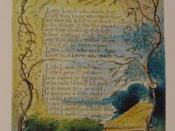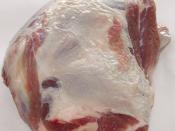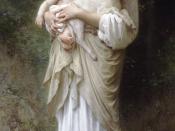The Lamb
In his poem, "The Lamb," Robert Blake writes of innocence by using biblical allusions, symbolism, and rhythm to convey a child's view of the world and religion. Combining these elements, the speaker questions who the Creator is and finally resolves that Jesus, the Lamb of God, made and blessed everything.
The speaker of the poem talks to a lamb throughout the entire poem. This can be interpreted as a biblical allusion to Jesus, who was often referred to as the "Lamb of God." The speaker tells the lamb that God made everything and it was him that caused the little lamb to feed in the meadows and play by the stream. God created the lamb's coat, "wooly, bright" and gave him a "tender voice, making all the vales rejoice." The lamb also alludes to Jewish Passover, when blood of the lamb was put on the doors to save the Jew's first born sons.
The main use of symbolism in "The Lamb" involves the lamb itself. It can be seen as a symbol for all believers. In God's eyes, we are seen as a lamb- innocent, meek, and in need of guidance, just as the lamb needs a shepherd to keep him safe from the wolf. The lamb is also like a child in its naivety and innocence. The lamb has a pure white coat, and children are born with a pure disposition that is unclouded by the sins of men. The speaker's questioning of how the lamb was brought into existence can be seen as a symbol for divine intervention. Just as God created the lamb, God created the valleys, meadows and streams mentioned in the poem.
The structure and rhythm of the poem creates the impression of a lamb bleating. The use of the letter...



Good Convergence of Symbolism...
Your evaluation of this poem is correct. Robert Blakes, "The Lamb" was most certainly written to be used as an impressionable form of literature on the young mind.
4 out of 4 people found this comment useful.